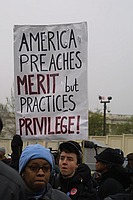 The Myth of Meritocracy, continued
The Myth of Meritocracy, continued
Why GPA is not a race-neutral admissions criterion
From Kindergarten through high school, racist inequality and segregation permeate education in America. Majority black and Latina/o schools receive less per-pupil funding, have fewer books, less academic, sports and art equipment and facilities, and have less diversity of course options, more uncertified teachers and larger class sizes. Latina/o K-12 students face more segregated conditions now than in the 1950’s and 1960’s.
Inequality and Segregation in K-12
The racial inequalities in K-12 are one of the obstacles that black, Latino and Native American students must overcome when they reach college, and with adequate support to compensate for the inferior education they received earlier, they DO overcome it – but they have to work HARDER than white students to do so . The first year that minority students who attended substandard K-12 schools spend ‘catching up’ is reflected in their GPA when they apply to graduate and professional schools.
A study of the period 1968-1987 conducted by UC-San Diego School of Medicine professors shows that initial gaps in performance between students admitted under the regular and affirmative action admission standards narrowed and then disappeared over the course of medical education. (see Robert Davidson end Ernest Lewis, “Affirmative Action and Other Special Consideration Admissions at the University of California, San Diego, School of Medicine,” 278 Journal of the American Medical Association 1153 (1997).
Uncapped GPA
Many universities, including the University of California, utilize “inflated” or “uncapped” GPA – the points added to a GPA of 4.0 for completion of AP, honors and IB courses. Some colleges simply give extra weight for graduation from “rigorous” programs or schools – which amounts to the same thing. The majority of Latino/a, black and Native American students attend schools that offer very few if any such courses. The first year that affirmative action was banned in California, 808 black and Latina/o students with a GPA of 4.0 were rejected from UC Berkeley. Such polices obviously privilege applicants who attend wealthier, better equipped high schools.
Racist Barriers Faced By Minority Students Who Attend Majority-White K-12
Racism also weighs on Latina/o and black students who attend majority white schools through tracking (which disproportionately pushes minority students into narrow vocational training), unequal discipline, higher suspension rates, and lower teacher expectations. Added to this, complex forms of prejudice challenge minority students in majority white schools, forcing students who would otherwise spend their full energy learning about the world and working out who they are to spend precious energy negotiating the rock-strewn waters between self-effacement and angry overreaction. Complicating this job further are both the variety of white comments and gestures that express some form of prejudice and also the uncertainty of calculating the proportions of ignorance and/or ill-will behind these comments and gestures.
Adding responsibility to education, black, Latino/a and other minority students in majority white schools are impelled to represent their race in a way that society never asks of white students; this task can be an honor and a source of pride, but also a burden.
Racism and sexism have an encumbering effect: they absorb mental energy, undermine self-confidence and influence academic performance. Affirmative action recognizes the encumbering effects of racism and sexism on student performance and seeks to counteract it – to reduce the effects of inequality and discrimination.
Negotiating a Racist Society Develops Character and Leadership Skills That Can’t be Quantified
While all these conditions are “obstacles” for black, Latina/o and Native American students that white students never face, they are also a singular source of strength of character that cannot be reflected in GPA or standardized test scores. Racism compels the development of resolve and thoughtful reflection. Academically successful minority students are forced to hone their social-assessment skills, enabling them to relate to people from a variety of different backgrounds often at a higher level of understanding than their white peers. Character sowed in the fields of racism harvests hard-won strengths.
Any real element of integration or equality in higher education in today’s America is not possible without offsetting the effects of racism by means of affirmative action.
Subscribe by Email
